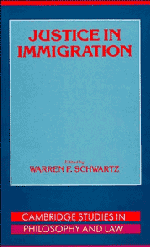Book contents
- Frontmatter
- Contents
- List of contributors
- 1 Immigration, welfare, and justice
- 2 Citizenship, the demands of justice, and the moral relevance of political borders
- 3 A two-country parable
- 4 Immigration, identity, and justice
- 5 Immigration, justice, and culture
- 6 Fear and loathing at the border
- 7 Immigration policy in liberal political theory
- 8 The welfare economics of immigration law: a theoretical survey with an analysis of U.S. policy
- 9 Just borders: normative economics and immigration law
- 10 Some caveats on the welfare economics of immigration law
- 11 The case for a liberal immigration policy
6 - Fear and loathing at the border
Published online by Cambridge University Press: 18 March 2010
- Frontmatter
- Contents
- List of contributors
- 1 Immigration, welfare, and justice
- 2 Citizenship, the demands of justice, and the moral relevance of political borders
- 3 A two-country parable
- 4 Immigration, identity, and justice
- 5 Immigration, justice, and culture
- 6 Fear and loathing at the border
- 7 Immigration policy in liberal political theory
- 8 The welfare economics of immigration law: a theoretical survey with an analysis of U.S. policy
- 9 Just borders: normative economics and immigration law
- 10 Some caveats on the welfare economics of immigration law
- 11 The case for a liberal immigration policy
Summary
Americans identify with America, and increasingly there are people – Poles, Italians, Israelis – who identify with two countries. But I do not know of any other identification that I can make, say, with the condition of the people of the Sahara. I repeatedly see pictures in the papers of a starving mother with her child holding out its hand. I think it would be hypocritical if I didn't say that I would feel a little more compassion if one of my pet birds had broken a leg in its cage in my own house.
Clare Booth LuceIn their thoughtful and original analysis of the immigration problem, Jules Coleman and Sarah Harding (Chapter 2, this volume) fail to take sufficient notice of the very deep emotions on the dark underside of immigration policy. One would not know from reading their account that the problem is politically situated in a world increasingly dominated by huge increases in population, rapidly dwindling resources, and ethnic hatred. The politics of immigration are driven by fear and selfishness, by prejudice and desperation.
A satisfactory analysis of the immigration problem must be grounded in this politics. It must incorporate political reality in two separate ways. First, it must evaluate the moral status of the racial, ethnic, and cultural antipathy that animates the immigration debate. Second, even if this antipathy is not morally defensible, the analysis must nonetheless take the fact of its existence into account in formulating a real-world, second-best solution to the immigration problem.
- Type
- Chapter
- Information
- Justice in Immigration , pp. 136 - 146Publisher: Cambridge University PressPrint publication year: 1995
- 1
- Cited by



